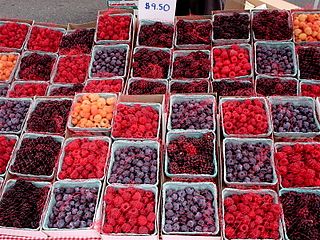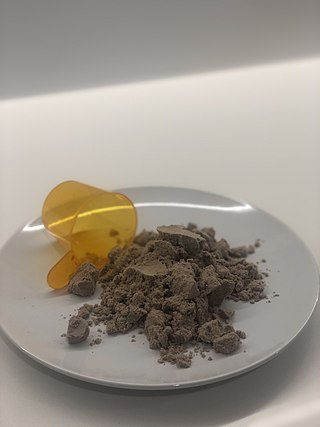
A bean is the seed of several plants in the family Fabaceae, which are used as vegetables for human or animal food. They can be cooked in many different ways, including boiling, frying, and baking, and are used in many traditional dishes throughout the world.

Vitamin C is a water-soluble vitamin found in citrus and other fruits and vegetables, also sold as a dietary supplement and as a topical "serum" ingredient to treat melasma and wrinkles on the face. It is used to prevent and treat scurvy. Vitamin C is an essential nutrient involved in the repair of tissue, the formation of collagen, and the enzymatic production of certain neurotransmitters. It is required for the functioning of several enzymes and is important for immune system function. It also functions as an antioxidant. Most animals are able to synthesize their own vitamin C. However, apes and monkeys, most bats, some rodents, and certain other animals must acquire it from dietary sources.

Vitamins are organic molecules that are essential to an organism in small quantities for proper metabolic function. Essential nutrients cannot be synthesized in the organism in sufficient quantities for survival, and therefore must be obtained through the diet. For example, Vitamin C can be synthesized by some species but not by others; it is not considered a vitamin in the first instance but is in the second. Most vitamins are not single molecules, but groups of related molecules called vitamers. For example, there are eight vitamers of vitamin E: four tocopherols and four tocotrienols.

Dietary fiber or roughage is the portion of plant-derived food that cannot be completely broken down by human digestive enzymes. Dietary fibers are diverse in chemical composition, and can be grouped generally by their solubility, viscosity, and fermentability, which affect how fibers are processed in the body. Dietary fiber has two main components: soluble fiber and insoluble fiber, which are components of plant-based foods, such as legumes, whole grains and cereals, vegetables, fruits, and nuts or seeds. A diet high in regular fiber consumption is generally associated with supporting health and lowering the risk of several diseases. Dietary fiber consists of non-starch polysaccharides and other plant components such as cellulose, resistant starch, resistant dextrins, inulin, lignins, chitins, pectins, beta-glucans, and oligosaccharides.
A nutrient is a substance used by an organism to survive, grow, and reproduce. The requirement for dietary nutrient intake applies to animals, plants, fungi, and protists. Nutrients can be incorporated into cells for metabolic purposes or excreted by cells to create non-cellular structures, such as hair, scales, feathers, or exoskeletons. Some nutrients can be metabolically converted to smaller molecules in the process of releasing energy, such as for carbohydrates, lipids, proteins, and fermentation products, leading to end-products of water and carbon dioxide. All organisms require water. Essential nutrients for animals are the energy sources, some of the amino acids that are combined to create proteins, a subset of fatty acids, vitamins and certain minerals. Plants require more diverse minerals absorbed through roots, plus carbon dioxide and oxygen absorbed through leaves. Fungi live on dead or living organic matter and meet nutrient needs from their host.

Digestion is the breakdown of large insoluble food molecules into small water-soluble food molecules so that they can be absorbed into the watery blood plasma. In certain organisms, these smaller substances are absorbed through the small intestine into the blood stream. Digestion is a form of catabolism that is often divided into two processes based on how food is broken down: mechanical and chemical digestion. The term mechanical digestion refers to the physical breakdown of large pieces of food into smaller pieces which can subsequently be accessed by digestive enzymes. Mechanical digestion takes place in the mouth through mastication and in the small intestine through segmentation contractions. In chemical digestion, enzymes break down food into the small molecules the body can use.

Sprouting is the natural process by which seeds or spores germinate and put out shoots, and already established plants produce new leaves or buds, or other structures experience further growth.
B vitamins are a class of water-soluble vitamins that play important roles in cell metabolism and synthesis of red blood cells. Though these vitamins share similar names (B1, B2, B3, etc.), they are chemically distinct compounds that often coexist in the same foods. In general, dietary supplements containing all eight are referred to as a vitamin B complex. Individual B vitamin supplements are referred to by the specific number or name of each vitamin, such as B1 for thiamine, B2 for riboflavin, and B3 for niacin. Some are more commonly recognized by name than by number, for example pantothenic acid, biotin, and folate.

Phytochemicals are chemical compounds produced by plants, generally to help them resist fungi, bacteria and plant virus infections, and also consumption by insects and other animals. The name comes from Greek φυτόν (phyton) 'plant'. Some phytochemicals have been used as poisons and others as traditional medicine.

Bran, also known as miller's bran, is the hard layers of cereal grain surrounding the endosperm. It consists of the combined aleurone and pericarp. Corn (maize) bran also includes the pedicel. Along with the germ, it is an integral part of whole grains, and is often produced as a byproduct of milling in the production of refined grains.

Inositol, or more precisely myo-inositol, is a carbocyclic sugar that is abundant in the brain and other mammalian tissues; it mediates cell signal transduction in response to a variety of hormones, neurotransmitters, and growth factors and participates in osmoregulation.

Digestive enzymes are a group of enzymes that break down polymeric macromolecules into their smaller building blocks, in order to facilitate their absorption into the cells of the body. Digestive enzymes are found in the digestive tracts of animals and in the tracts of carnivorous plants, where they aid in the digestion of food, as well as inside cells, especially in their lysosomes, where they function to maintain cellular survival. Digestive enzymes of diverse specificities are found in the saliva secreted by the salivary glands, in the secretions of cells lining the stomach, in the pancreatic juice secreted by pancreatic exocrine cells, and in the secretions of cells lining the small and large intestines.
Prebiotics are compounds in food that foster growth or activity of beneficial microorganisms such as bacteria and fungi. The most common example is in the gastrointestinal tract, where prebiotics can alter the composition of organisms in the gut microbiome.

Phytic acid is a six-fold dihydrogenphosphate ester of inositol, also called inositol hexakisphosphate (IP6) or inositol polyphosphate. At physiological pH, the phosphates are partially ionized, resulting in the phytate anion.

A phytase is any type of phosphatase enzyme that catalyzes the hydrolysis of phytic acid – an indigestible, organic form of phosphorus that is found in many plant tissues, especially in grains and oil seeds – and releases a usable form of inorganic phosphorus. While phytases have been found to occur in animals, plants, fungi and bacteria, phytases have been most commonly detected and characterized from fungi.

Galactooligosaccharides (GOS), also known as oligogalactosyllactose, oligogalactose, oligolactose or transgalactooligosaccharides (TOS), belong to the group of prebiotics. Prebiotics are defined as non-digestible food ingredients that beneficially affect the host by stimulating the growth and/or activity of beneficial bacteria in the colon. GOS occurs in commercially available products such as food for both infants and adults.

Pea protein is a food product and protein supplement derived and extracted from yellow and green split peas, Pisum sativum. It can be used as a dietary supplement to increase an individual's protein or other nutrient intake, or as a substitute for other food products. As a powder, it is used as an ingredient in food manufacturing, such as a thickener, foaming agent, or an emulsifier.
Protein quality is the digestibility and quantity of essential amino acids for providing the proteins in correct ratios for human consumption. There are various methods that rank the quality of different types of protein, some of which are outdated and no longer in use, or not considered as useful as they once were thought to be. The Protein Digestibility Corrected Amino Acid Score (PDCAAS), which was recommended by the Food and Agriculture Organization of the United Nations (FAO), became the industry standard in 1993. FAO has recently recommended the newer Digestible Indispensable Amino Acid Score (DIAAS) to supersede PDCAAS. The dairy industry is in favor of this, because while PDCAAS truncates all protein types that exceed the essential amino acid (EAA) requirements to 1.0, DIAAS allows a higher than 1.0 ranking: while for example both soy protein isolate and whey isolate are ranked 1.0 according to PDCAAS, in the DIAAS system, whey has a higher score than soy.

Lipase inhibitors belong to a drug class that is used as an antiobesity agent. Their mode of action is to inhibit gastric and pancreatic lipases, enzymes that play an important role in the digestion of dietary fat. Lipase inhibitors are classified in the ATC-classification system as A08AB . Numerous compounds have been either isolated from nature, semi-synthesized, or fully synthesized and then screened for their lipase inhibitory activity but the only lipase inhibitor on the market is orlistat . Lipase inhibitors have also shown anticancer activity, by inhibiting fatty acid synthase.

Zinc is an essential trace element for humans and other animals, for plants and for microorganisms. Zinc is required for the function of over 300 enzymes and 1000 transcription factors, and is stored and transferred in metallothioneins. It is the second most abundant trace metal in humans after iron and it is the only metal which appears in all enzyme classes.
















